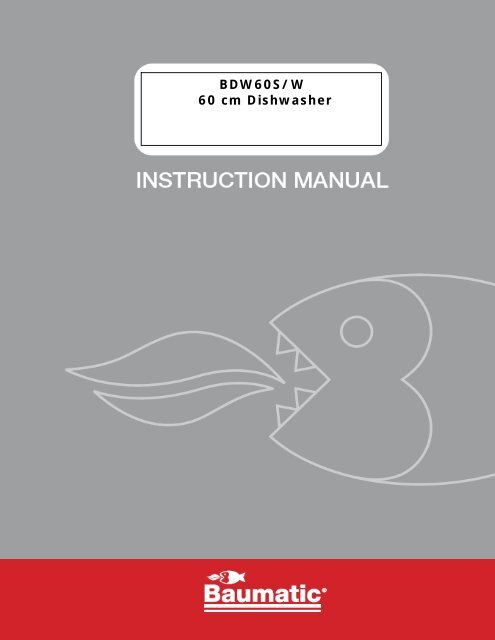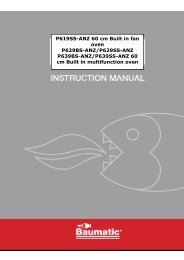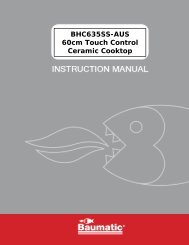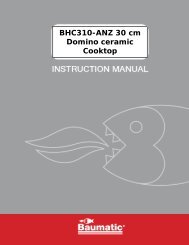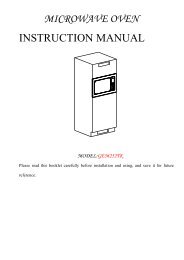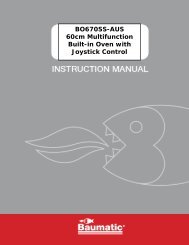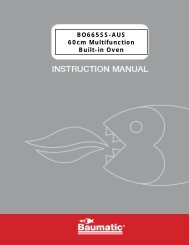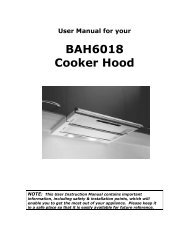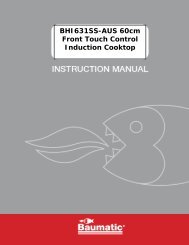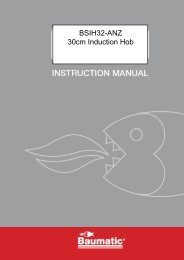BDW60S/W 60 cm Dishwasher - Baumatic
BDW60S/W 60 cm Dishwasher - Baumatic
BDW60S/W 60 cm Dishwasher - Baumatic
- No tags were found...
You also want an ePaper? Increase the reach of your titles
YUMPU automatically turns print PDFs into web optimized ePapers that Google loves.
<strong>BDW<strong>60</strong>S</strong>/W<strong>60</strong> <strong>cm</strong> <strong>Dishwasher</strong>1
Dear Customer,Congratulations on purchasing your new product from Think Appliances.To register your parts and labour warranty (some conditions apply please refer to yourwarranty card for more details) please contact out Customer Care team on:1800 444 357Our Customer Care centre is there to ensure you get the most out of your appliance. Forexample, should you want to learn more about recommended cooking temperatures, thevarious cooking functions available, how to set and program your LED clock, and importantlytaking care of your appliance when cleaning, please call us because we are here to help you.It is important that you read through the following use and care manual thoroughly tofamiliarize yourself with the installation and operation requirements of your appliance toensure optimum performance.We also carry a complete range of spare parts for all Think products. For all your spare partsenquiries please contact our team at Pronto Parts on:1300 306 973Again, thank you for choosing an appliance brought to you by Think Appliances and we lookforward to being of service to you.Kind regardsManagementThink Appliances
Dear Customer,Please read this User Manual carefully and keep itto refer to at a later date.Pass it on to any subsequent owner of the appliance.This manual contains sections of Safety Instructions,Operating Instructions,Installation Instructions and Troubleshooting Tips etc.Carefully reading it before using the dishwasher will helpyoutouseandmaintainthe dishwasher properly.Control Panel......................................................2<strong>Dishwasher</strong> Features...........................................2Rinse Aid.........................................................3, 4Detergent........................................................ 5How to use the 3in1 programme........................... 6Not suitable for the dishwasher............................8At the end of the wash cycle ................................9Wash Cycle Table...............................................10Turning on the Appliance.................................... 11Change the Programme................. ..................... 11Forget to add a Dish................. ...........................12Filtering System..................................................12Caring for the <strong>Dishwasher</strong>..........................12,13, 14Please review the section on Trouble Shooting Tipsbefore calling an Authorised Service Agent.Water Connection...............................................15Connection of drain hoses.................................... 15,16Start of dishwasher...........................................16The manufacturer, following a policy of constantdevelopment and up-dating of the product, maymake modifications without giving prior notice.Before calling for service...............................17, 18Error codes.......................................................18Technical information....................................... 19
This appliance must be grounded. In the event of amalfunction or breakdown, grounding will reducetheriskof anelectricshockbyprovidingapathofleast resistance of electric current. This applianceis equipped with a cord having an equipmentgroundingconductor and a grounding plug.The plug must be plugged into an appropriate outletthat is installed and grounded in accordance withall local codes and ordinances.Improper connection of the equipment-groundingconductor can result in the risk of an electric shock.Check with a qualified electrician or servicerepresentative if you are in doubt whether theappliance is properly grounded. Do not modify theplug provided with the appliance; If it does not fitthe outlet. Have a proper outlet installed by aqualified electrician.• Do not abuse, sit on, or stand on the door or dish rack of the dishwasher• Do not operate your dishwasher unless all enclosure panels are properly in place. Open the door verycarefully if the dishwasher is operating. There is a risk of water squirtingout.• Do not place any heavy objects on the door when it is open, or the appliance could tip forward.• When loading items to be washed:o Locate sharp items so that they are not likely to damage the door seal;o Load sharp knives with the handles up to reduce the risk of cut-type injuries;o Warning: knives and other utensils with sharp points must be loaded in the basket with their points downor placed in a horizontal position.• When using your dishwasher, you should prevent plastic items from contacting with heating element.• Check that the detergent receptacle is empty after completion of the wash cycle.• Do not wash plastic items unless they are marked dishwasher safe or the equivalent. For plastic items notso marked, check the manufacturer's recommendations.• Use only detergent and rinse additives designed for an automatic dishwasher. Never use soap, laundrydetergent, or hand washing detergent in your dishwasher.• Keep children away from detergent and rinse aid, keep children away from the open door of the dishwasher,there could still be some detergent left inside.• Young children should be supervised to ensure that they do not play with the appliance.• The appliance is not intended for use by young children or infirm persons without supervision.• <strong>Dishwasher</strong> detergents are strongly alkaline. They can be extremely dangerous if swallowed. Avoid contactwith skin and eyes and keep children away from the dishwasher when the door isopen.• The door should not be left in the open position since this could present a tripping hazard.• This dishwasher is designed for normal household and indoor use.• If the supply cord is damaged, it must be replaced by the manufacturer or its service agent or a similarlyqualified person in order to avoid a hazard.• Please dispose of packing materials properly.• Use the dishwasher only for its intended function.• During installation, the power supply must not be excessively or dangerously bent or flattened.• Do not tamper with controls.• The appliance is to be connected to the water mains using new hose sets and the old hose-sets should notbe reused.• This appliance is not intend for use by persons(include children) with reduced physical , sensory or mentalcapabilities, or lack of experience and knowledge, unless they have been given supervision or instructionconcerning use of the appliance by a person responsible for their safety• Please unplug before cleaning the appliance.1
To get the best performance from your dishwasher, please read the instructions carefully.326 5 411 ON/OFF Button: To turn on/off the power supply.2 Power Light : To come on when the ON/OFF Button isPressed down.3 Rinse Aid Warning Light : To come on when therinse aid dispenser needs to be refilled.4 Start / Reset Button: Press this button to start or pause thedishwasher, the process pilot lamp will come on whenstarting.5 Program button: Press the button to choose the desiredprogram.6 Program indicator light.123674859 10111 Upper Basket 42 Spray Arms3 Lower Basket56Main FilterDetergent DispenserCup Shelf789Silverware BasketCoarse FilterRinse Aid Dispenser1011Drain pipe connectorInlet pipe connector2
Before using your dishwasher for the first time:A. Fill the rinse aid dispenserB. Function of detergentRinse aid is automatically added during the last rinse, ensuring thorough rinsing, spotandstreakfreedrying.Only use branded rinse aid for dishwasher. Never fill the rinse aid dispenser with anyother substances (e.g. dishwasher cleaning agent, liquid detergent).This will damage the appliance.If there is no rinse-aid warning light in the control panel, you can judge the amount of rinse-aid by the color of the optical levelindicator "D" located next to the cap. When the rinse-aid container is full, the whole indicator will be dark . As the rinse-aiddiminishes, the size of the dark dot decreases. You should never let the rinse aid get below 1 / 4 full.Astherinseaiddiminishes,thesizeoftheblackdoton the rinse aid level indicator changes, as illustrated right.Full3/4full1/2full1 / 4 full - Should refill to eliminate spottingEmptyD (Rinse-Aid indicator)OPENCLOSE123To open the dispenser, turn the cap to the "open" (left) arrow and lift it out.Pour the rinse aid into the dispenser, being careful not to overfill.Replace the cap by inserting it aligned with "open" arrow and turning it to the closed (right) arrow.The rinse aid is released during the final rinse to prevent water from forming droplets on your dishesthat can leave spots and streaks. It also improves drying by allowing water to sheet off the dishes.Your dishwashers are designed to use liquid rinse aids. The rinse aid dispenser is located inside thedoor next to the detergent dispenser. To fill the dispenser, open the cap and pour the rinse aid intothe dispenser until the level indicator turns completely black. The volume of the rinse aid containeris about 140ml.Be careful not to overfill the dispenser, because this could cause over sudsing. Wipe away any spillswith a damp cloth. Don't forget to replace the cap before you close dishwasher door.Attention!Clean up any rinse aid split during filling with an absorbent cloth to avoid excess foamingduring the next wash.The rinse aid dispenser has six or four settings. Always start with the dispenser set on“2”. If spots and poor drying are problems, increase the amount of rinse aid dispensedby removing the dispenser lid and rotating the dial to “3”. If the dishes still are notdrying properly or are spotted, adjust the dial to the next higher number until your dishesare spot-free. We suggest you to set on “4”(Factory value is “4”)NOTE:Increase the dose if there are drops of water or lime spots on the dishes after washing.Reduce it if there are sticky whitish streaks on the dishes or a bluish film on glassware orknife blades.3MAXAdjust lever(Rinse)
Detergents with its chemical ingredients are necessary to remove dirt, crush dirt andtransport it out of the dishwasher. Most of commercial quality detergents are suitablefor this purpose.Concentrated DetergentBased on their chemical composition, dishwasher can be split in two basic types:conventional, alkaline detergents with caustic componentslow alkaline concentrated detergents with natural enzymesThe use of “heavy” washing programmes in conjunction with concentrated detergentsreduces pollution and is good for your dishes; these wash programmes are specially matchedto the dirt-dissolving properties of the enzymes of the concentrated detergent. For this reason“heavy”wash programmes in which concentrated detergents are used can achieve thesame results that can otherwise only be achieved using “intensive” programmes.Detergent TabletsDetergent tablets of different brands dissolve at different speeds. For this reason somedetergent tablets cannot dissolve and develop their full cleaning power during shortprogrammes. Therefore please use long programmes when using detergent tablets, tounsure the complete removal of detergent residuals.Detergent DispenserThe dispenser must be refilled before the start of each wash cycle following the instructionsprovided in the Wash Cycle Table. Your dishwashers use less detergent and rinse aidthen conventional dishwashers. Generally, only one tablespoon of detergent is needed fora normal wash load. Also, more heavily soiled items need more detergent. Always add thedetergent just before starting dishwasher, otherwise it could etc damp and will not dissolveproperly.Amount of Detergent to Use12If the lid is closed: press release button. The lid springs open.Always add the detergent just before starting each wash cycle.Only use branded detergent aid for dishwasher.<strong>Dishwasher</strong> detergent is corrosive! Take care to keep it out of reach of children.Proper Use of DetergentUse only detergent specifically made for use in dishwashers. Keep your detergent freshand dry. Don't put powder detergent into the dispenser until you're ready to wash dishes.4
Fill in detergent1 2Fill the detergent dispenser with detergent.The marking indicates the dosing levels , asillustrated on right:1 The place of main wash cycle detergent placed ,“MIN”means approximately 20g of detergen.2 The place of pre-washcycle detergent placed ,approximately 5g of detergentPlease observe the manufacturers dosing and storagerecommendations as stated on the detergent packaging.Close the lid and press until it locks in place.If the dishes are heavily soiled, place an additional detergent dose in the pre-wash detergentchamber. This detergent will take effect during the pre-wash phase.NOTE:You find information about the amount of detergent for the single programmes on thelast page. Please aware, that according to the level soiling and the specific hardness ofwater differences are possible.Please observe the manufacturer's recommendations on the detergent packaging.DetergentsThere are 3 sorts of detergents1.With phosphate and with chlorine2.With phosphate and without chlorine3.Without phosphate and without chlorideUse of “ 2 in 1”、“ 3 in 1”、“ 4 in 1” and “ 5 in 1”Combination / Compact DetergentsWhen use “ 2 in 1”、“ 3 in 1”、“ 4 in 1” or “ 5 in 1”Combination / Compact Detergents,please pay attention to make sure that the size of the Combination Detergentsis fitted to the dispenser , so that Combination Detergents can be ease to put in thedispenser ,and dispenser would not be broken.AttentionKeep all detergents in a safe place out of children's reach.Always add the detergent in the dispenser just before starting the dishwasher.Your dishwasher has a 3 in 1 program which needs not rinse aid but a THREE INONE tablet. And this dishwasher comes with a 3 in 1 tablet container as an accessory.NOTE: Only 3 in 1 program uses 3 in 1 tablet. If using 3 in 1 tablet in other programs, theappliance will not get a best performance.1、Referringtothebelowsketchmap,hangthe3 in 1 tablet container on the upper basket.2、 Referring to the below sketch map, rotate the upper sprayer and change the location of the container ifneed to makesure the upper sprayer does not be cumbered by the 3 in 1 tablet container.3、Put the 3 in 1 tablet into the container then start the 3 in 1 program.5
11For best performance of the dishwasher, follow these loading guidelines. Features andappearance of racks and silverware baskets may vary from your model.Attention before or after Loading the <strong>Dishwasher</strong> RacksScrape off any large amounts of leftover food. It is not necessary to rinse the dishes underrunning water. Place objects in the dishwasher in following way:1.Items such as cups, glasses, pots/pans, etc. are stood upside down.2.Curve items, or those with recesses, should be at a slant so that water can run off.3.They are stacked securely and can not tip over.4.They do not prevent the spray arms from rotating while washing takes place.Very small items should not be washed in the dishwasher as they could easily fall out of the racks.Removing the DishesTo prevent water dripping from the upper back into the lower back, we recommend that youempty the lower basket first and then the upper back.Loading the Upper RackThe upper rack is designed to hold more delicate and lighter dishware such as glasses, coffeeand tea cup and saucers, as well as plates, small bowls and shallow pans (as longastheyarenot too dirty).Position the dishes and cookware so that they do not get moved by the spray of water.1141 Cups2 Glasses3 Saucers2 2 2314 Dessert dishesAdjusting the Upper RackIf required, the height of the upper rack can be adjusted in order to create more space for largeutensils either in the upper rack or lower rack. The upper rack can be adjusted for height byputting wheels of different height into the rails. Long items, serving cutlery, salad servers orknives should be placed on the shelf so that they do not obstruct the rotation of the spray arms.The shelf can be folded back or removed when not required for use.6
We recommend that you place large items which are most difficult to clean into the lower rack:pots, pans, lids, serving dishes and bowls, as shown in the figure to the right.It is preferable to place serving dishes and lids on the side of the racks in order to avoid blockingthe rotation of the top spray arm.Pots, serving bowls, etc. must always be placed top down.Deep pots should be slanted to allow water to flow out.The bottom rack feature fold down tine rows so that larger or more pots and pans can be loaded.5567 4456Dessert dishesSoup platesDinner plates7 Silverware basketTo improve stacking of pots and pans, the spikes can be folded down7
Silverware BasketSilverware should be placed in the silverware basket with handles at the bottom: If the rackhas side baskets, the spoon should be loaded individually into the appropriate slots,especially long utensils should be placed in the horizontal position at the front of theupper rack.44444444444441111111111115 3 3 25 25 3 3 25 3 3 25 25 3 3 2555555333322222212Soup spoons3 Dessert spoons4 TeaspoonsKnife5ForksDo not let any cutlery fall through the bottomof the basket.Are not suitableCutlery with wooden, horn china ormother-of-pearl handlesPlastic items that are not heat resistantOlder cutlery with glued parts that is nottemperature resistantBonded cutlery items or dishesPewter or cooper itemsLead crystal glassSteel items subject to rustingWooden plattersItems made from synthetic fibresAre of limited suitabilitySome types of glasses can becomedull after a large number of washesSilver and aluminium parts have atendency to discolour during washingGlazed patterns may fade if machinewashed frequentlyNOTE:Do not place items in the dishwasher that have cigarette ash, candle wax,lacquer or paint on them. If you buy new dishes please makesure that they are suitable for dishwashers.NOTE:Please note there is only space for 12 standard dishes,so to get the best results from your dishwasher you mustensure you do not overload this.Loading cutlery and dishesBefore loading the dishwasher, ensure you remove anyleft over food and any remnants of burnt food fromyour pots and pans.When loading the dishes and cutlery, please note:Dishes and cutlery must not impede the rotation of the spray armsLoad hollow items such as cups, glasses, pans etc. with the opening downwards so thatwater cannot collect in the container or a deep base.8
Dishes and items of cutlery must not lie inside one another, or cover each otherTo avoid damage to glasses, they must not touchLoad large items which are most difficult to clean into the lower rackThe upper rack is designed to hold more delicate and lighter dishware such as glasses, coffeeand tea cupsAttention!Long bladed knives stored in an upright position are a potential hazard!Long and/or sharp items of cutlery such as carving knives must be positionedhorizontally in the upper basket.Damage to glassware and other dishesPossible causes:Type of glass or manufacturing process. Chemical composition of detergent.Water temperature and duration of dishwasher programme.Suggested remedy:Use glassware or porcelain dishes that have been marked dishwasher-proof by themanufacturerUseamilddetergentthatisdescribedaskindofdishesIfnecessary,seekfurtherinformation from detergent manufacturers.Select a programme with as low a temperature.To prevent damage, take glass and cutlery out of the dishwasher as soon as possibleafter the programme has ended.At the End of the Wash CycleWhen the cycle has finished, the buzzer will sound for 8 seconds,and will then stop. Wait a few minutes before opening the dishwasherto allow the dishes to dry as are also more susceptible to breakage.9
For normally soiled loads,such as pots, plates,glassesand lightly soiled pans.standard daily cycle.Pre-washpre-washwash(45 ℃ )rinse(70 ℃ )drying3in11<strong>60</strong>1.1016.2IntensiveFor the heaviest soiled loads,such as pots,pans,casseroledishes and dishes that havebeensittingwithdriedfoodon them for a while.Pre -wash(45℃)Wash (50 ℃)Rinse (70 ℃)Drying5/25 g.1501.5517.7HeavyFor heavy soiled loads,such as pots, plates,glassesand lightly soiled pans.standard daily cycle.Pre-washPre-washWash (50 ℃)Rinse (70 ℃)Drying5/25 g.1501.2517.4Normal(AS/NZS 2007.1 )For normal soiled loads,suchas plates,glasses,bowls andlightly soiled pans.Pre-washPre-washWash (45 ℃)Rinse (55 ℃)Drying25 g.1150.6513.7RinseFor dishes that need to berinsed and dried only.Pre-washRinse (70 ℃)Drying750.87.6GlassFor lightly soiled loads,such as glasses, crystal andfine china.Pre-washwash(40 ℃ )rinse(<strong>60</strong> ℃ )drying20 g.950.7513.2RapidA shorter wash for lightlysoiled loads that do notneed drying.Wash (40 ℃)Rinse (50 ℃)20 g.500.69.9To rinse dishes that youplan to wash later that day.Pre-wash8 0.01 3.7Soak10
Turning on the ApplianceStarting a wash cycle...1234Draw out the lower and upper basket, load the dishes andpush them back. It is commended that loading the lowerbasket first, than the upper one (see the section entitled“Loading the <strong>Dishwasher</strong>”).Pour in the detergent (see the section entitled “ Detergentand Rinse Aid”).Insert the plug into the socket. The power supply is 220-240VAC 50 HZ, the specification of the socket is 12 A 250 VAC.Make sure that the water supply is turned on to full pressure.When select 8 kinds of wash programPress the programme button, the wash program will change as follows direction3in1->Intensive->Heavy->Normal->Rinse->Glass->Rapid->Soak;When a program is selected, the response light will light. Then press theStart/Reset button, the program is running.Premise: You can modified the washing program, justthe dishwasher has been running for a short time. Otherwise,the detergent may have already been released, and the appliancemay have already drained the wash water. If this is the case, the detergentdispenser must be refilled (see the section entitled " Loading theDetergent " ).Press start/Reset Button more than three seconds the machine willbe in stand by state ,then you can change the program tothe desired cycle setting (see the section entitled " Starting a wash cycle...").NOTE: If you open the door when washing, the machinewill pause. When you close the door and press the start/reset Button,the machine will keep on working after 10 seconds.The program lights shows the state of the dishwasher:a) All program lights off---------------stand byb) One of the program lights on----------pausec) One of the program lights blinking----- runNOTE:If all the lights begin to glimmer, that indicates the machine is out of order, please turn off themain power and water supply before calling a service.11
A forgotten dish can be added any time before the detergent cup opens.12Open the door a little to stop the washing.After the spray arms stop working,you can open the doorcompletely.34Add forgotten dishes.Close the door, then press the start/reset button ,the dishwasherwill work after ten second.It is dangerous to open the door when washing,because the hot water may scald you.The program light is on but isn't blinking, only in this case the program is ended.1.Switch off the dishwasher by pressing the ON/OFF button.2.Turn off the water tap!Open the door carefully. Hot steam may escape when the door is opened!Hot dishes are sensitive to knocks. The dishes should be allowed to cool down around15 minutes before removing from the appliance.Open the dishwasher's door, leave it ajar and wait a few minutes before removing the dishes.In this way they will be cooler and the drying will be improved.Unloading the dishwasherIt is normal that the dishwasher is wet inside.Empty the lower basket first and then the upper one. This will avoid water dripping from theupper basket onto the dishes in the lower one.Maintenance and CleaningFiltering SystemThe filter prevents larger remnants of food or other objects from getting inside the pump.The residues may block the filter, in this case they must be removed.The filter system consists of a coarse filter, a flat (Main filter)And a microfilter (Fine filter).213Caring for the <strong>Dishwasher</strong>To clean the control panel use a lightly dampened cloth then dry thoroughly. To clean the exterioruse a good appliance polish wax.Never use sharp objects, scouring pads or harsh cleaners on any part of the dishwasher.Protect Against FreezingMain filterFood and soil particles trapped in this filter are pulverized by aspecial jet on the lower spray arm and washed down thedrain.Coarse filter 2Larger items, such as pieces of bones or glass, that could clogthe drain are trapped in the coarse filter. To remove an itemcaught in this filter, gently squeeze the taps on the top of thisfilter and lift it out.Fine filterThis filter holds soil and food residues in the sump area andprevents it from being redeposit on the dishes during a cycle.If your dishwasher is left in an unheated place during the winter, ask a service technical to:1.Cut off electrical power to the dishwasher.2.Turn off the water supply and disconnect the water inlet pipe from the water valve.3.Drain water from the inlet pipe and water valve. (Use a pan to catch the water)4.Reconnect the water inlet pipe to the water valve.5.Remove the filter in the tub the bottom and use a sponge to use up water in sump.1312
Cleaning the Spray ArmsIt is necessary to clean the spray arms regularly for hard water chemicals will clog the spray arm jets and bearings.upperlowerRemove the upper spray armsTo remove the upper spray arms, screw off the nut clockwise to take outthe washer on top of the spray arm and remove the arm.Remove the lower spray armsTo remove the lower spray arm, pull out the spray arm upward.Wash the armsWash the arms in soapy and warm water and use a soft brush to cleanthe jets. Replace them after rinsing them thoroughly.Cleaning the Filters- Inspect the filters for blocking after every time the dishwasher has been used.- By unscrewing the coarse filter. you can remove the filter system. Remove any food remnants and clean thefilters under running water.Open1step1:Turn the filter in anti-clockwise direction,then lift it up2step2:lift the Main filter up3step 3: lift the Fine filter upNOTE:When following this procedure from step1 to step 3, the filter system will beremoved;whenfollowingitfromStep3toStep1,thefiltersystemwillbeinstalled.Filter assemblyFor best performance and results, the filter assembly must be cleaned regularly. The filter efficientlyremovesfoodparticlesfromthewashwater,allowingittoberecirculatedduring the cycle. Forthis reason, it is a good idea to remove the larger food particles trapped in the filter after eachwash cycle by rinsing the semicircular filter and cup under running water. To remove the filterassembly, pull on the cup handle in the upward direction. The entire filter assembly should becleaned once a week.To clean the coarse filter and the fine filter, use a cleaning brush. Then, reassemble the filterparts as shown in the figures left and reinsert the entire assembly in the dishwasher, positioningin its seat and pressing downward.The dishwasher must never be used without the filters. Improper replacement of the filter mayreduce the performance level of the appliance and damage dishes and utensils.Never run the dishwasher without the filters in place. When cleaning the filters, don't knock onthem. Otherwise, the filters could be contorted and the performance of dishwasher could bedebased.13
To clean the edge around the door, you should use only a soft warm, damp rag. To preventpenetration of water into the door lock and electrical components, do not use a spray cleanerof any kind.Also, never use abrasive cleaners or scouring pads on the outer surfaces because they willscratch the finish. Some papers towels can also scratch or leave marks on thesurface.Never use a spray cleaner to clean the door panel for it could damage the door lock and electrical components. It is not allowedto use the abrasive agent or some paper towel becauseof the risk of scratching or leaving spots on the stainless steel surface.After every wash, turn off the water supply to theappliance and leave the door slightly ajar so thatmoisture and odors are not trapped inside.Before cleaning or performing maintenance, alwaysremove the plug from the socket. Do not run risks.To clean the exterior and rubber parts of the dishwasher,do not use solvents or abrasive cleaning products.Rather, use only a cloth and warm soapy water.To remove spots or stains from the surface of theinterior, use a cloth dampened with water and a littlewhite vinegar, or a cleaning product made specificallyfor dishwashers.When you go on holiday, it is recommened that you run awash cycle with the dishwasher empty and then removethe plug from the socket, turn off the water supply andleave the door of the appliance slightly ajar. This will helpthe seals last longer and prevent odors from formingwithin the appliance.If the appliance must be moved, try to keep it in the verticalposition.If absolutely necessary, it can be positioned onits back.One of the factors that cause odors to form in thedishwasher is food that remains trapped in the seals.Periodic cleaning with a damp sponge will prevent thisfrom occurring.Please see the rating label to know the rating voltage and connect the dishwasher to appropriate power supply, which has arequired fuse 16 amp. Time delay fuse or circuit breaker recommended and provide separate circuit serving only this appliance.Insure proper ground exists before useAfter making sure that the voltage and the frequency values for the current in the homecorrespond to those on the rating plate and that the electrical system is sized for themaximum voltage on the rating plate, insert the plug into an electrical socket which isearthed properly. If the electrical socket to which the appliance must be connected is notappropriate for the plug , replace the socket,rather than using a adaptors or thelikeasthey could cause overheating and burns.• This appliance must be grounded. In the event of a malfunction or breakdown, grounding willreduce the risk of electric shock by providing a path of least resistance of electric current. Thisappliance is equipped with a cord having an equipment-grounding conductor and a groundingplug. The plug must be plugged into an appropriateoutlet that is installed and grounded in accordancewith all local codes and ordinances.14
• Improper connection of the equipment-grounding conductor can result in a riskof electric shock. Check with a qualified electrician or service representative if youare in doubt whether the appliance is properly grounded. Do not modify the plugprovided with the appliance; If it is not fit for the outlet. Have a proper outlet installedby a qualified electrician.In order to avoid that there is more water staying in the inlet hose,please close the hydrant after using.(For the models: no safety inlet hose.)Connect the cold water supply hose to a threaded 3/4(inch) connector and make sure that it isfastened tightly in place.If the water pipes are new or have not been used for an extended period of time, let the waterruntomakesurethatthewaterisclearandfreeofimpurities.Ifthisprecaution is not taken,there is a risk that the water inlet can get blocked and damage the appliance.The water supply to the appliance can also be connected to the house hot waterline(centralized system, heating system),as long as it does not exceed a temperature of <strong>60</strong> C.In this case, the wash cycle time will be shortened by about 15 minutes and thewashefficiency slightly reduced.The connection must be made to the hot water line following the same procedures as thosefor the connection to the cold water line.Position the appliance in the desired location. The back should rest against the wall behind it, and the sides, along the adjacentcabinets or wall. The dishwasher is equipped with water supply and drain hoses that can be positioned to the right or the left tofacilitate proper installation.<strong>Dishwasher</strong> must be level for proper dish rack operation and wash performance.1 Place level on door and rack track inside the tub as shown to check that thedishwasher is level.2 When level the dishwasher, please pay attention not to let the dishwasher tip over.Insert the drain hose into a drain pipe with a minimum diameter of 40 mm, or let it run into the sink, making sure to avoid bendingor crimping it. Use the special plastic support that comes with the appliance. The free end of the hose must be at a heightbetween 400 and 1000mm and must not be immersed in water.SINKDISHWASHERPO WER OUTLETInlet pipe connectorDrain pipe connectorFRONT VIEWMin 100mm15
If the sink is 1000 higher from the floor, the excess water in hoses cannotbe drained directly into the sink. It will be necessary to drain excesswater from hoses into a bowl or suitable container that is held outside and lowerthan the sink.In order to avoid more water staying in the inlet hose,please close the hydrant after using.(For the models: no safety inlet hose.)Water OutletConnect the water drain hose. The drain hose must be correctly fitted to avoid water leaks.Ensure that the water drain hose is not kinked or squashed.Extension HoseIf you need a drain hose extension, make sure to use a similar drain hose.It must be no longer than 4 metres; otherwise the cleaning effect of the dishwasher could be reduced.Syphon ConnectionThe waste connection must be at a height of between 40 <strong>cm</strong> (minimum) and 100 <strong>cm</strong> (maximum)from the bottom of the dish. The water drain hose should be fixed by a hose clip.Thefreeendofthe hose must not be immersed in water.●Start of dishwasherThe followings should be checked before starting the dishwasher.1 Whether the dishwasher is level and fixed2 Whether the inlet valve is opened3 Whether there is leakage at the connections of the conducts4 Whether the wires are tightly connected5 Whether the power is switched on6 Whether the inlet and drain hoses are knotted7 All packing materials and printings should be taken out from the dishwasher●AttentionAfter installation, please put this manual into the bags of printings. The contentof this manual is very helpful to the users.16
Before Calling for Service''Fuse blown, or thecircuit breaker actedPower supply is notturned onWater pressure is lowSome audible sounds arenormalUtensils are not securein the baskets or somethingsmall has dropped intothe basketMotor humsImproper detergentSpilled rinse agentReplace fuse or reset circuit breaker. Remove any otherappliances sharing the same circuit with the dishwasherMake sure the dishwasher is turned on and the door isclosed securely.Make sure the power cord is properly plugged into thewall socket.Check that the water supply is connected properly andthe water is turned on.Sound from soft food shredding action and detergent cupopening.To ensure everything is secured in the dishwasher.<strong>Dishwasher</strong> has not been used regularly. If you do not use itoften, remember to set it to fill and pump out every week,which will help keep the seal moist.Use only the special dishwasher detergent to avoid suds.If this occurs, open the dishwasher and let suds evaporate.Add 1 gallon of cold water to the tub. Close and latch thedishwasher, then Start the wash cycle to drain out thewater .. Repeat if necessary.Always wipe up rinse agent spills immediately.Detergent withcolorant was usedRinse agent dispenseris emptyImproper programImproper rack loadingMake sure that the detergent is the one without colorant.Make sure that the rinse agent dispense is filled.Select stronger programMake sure that the action of the detergent dispenser andspray arms are not blocked by large dishware.Extremely hard waterLow inlettemperatureOverloading thedishwasherImproper loadingOld or damp powderdetergentEmpty rinse agentdispenserIncorrect dosage ofdetergentTo remove spots from glassware:Take out all metal utensils out of the dishwasher.Do not add detergent.Choose the longest cycle.Start the dishwasher and allow it to run for about18 to 22 minutes, then it will be in the main wash.Open the door to pour 2 cups of white vinegarinto the bottom of the dishwasher.Close the door and let the dishwasher completethe cycle. If the vinegar does not work: Repeatas above, except use 1/4 cup (<strong>60</strong> ml)of citric acidcrystals instead of vinegar.17
Combination of softwater and too muchdetergentTea or coffee stainsUse less detergent if you have soft water and select ashortest cycle to wash the glassware and to get them clean.using a solution of 1/2 cup of bleach and 3 cups warm waterto remove the stains by hand.You have to wait for 20 minutes after a cycle to let the heatingelements cool down before cleaning interior; otherwise, burnswill happen.Iron deposits in watercan cause an overall filmYou have to call a water softener company for a special filter.Hard water mineralsTo clean the interior, use a damp sponge with dishwasherdetergent and wear rubber gloves. Never use any other cleanerthan dishwasher detergent for the risk of foaming or suds.'Dial is not in the OFFpositionDishes block detergentcupsNormal phenomenonAluminum utensils haverubbed against dishesThis is normalTurn the Dial to OFF position and slide the door latch to theleft.Re-loading the dishes properly.Thereissomesteamcomingthroughtheventbythedoorlatch during drying and water draining.Use a mild abrasive cleaner to eliminate those marks.A small amount of clean water around the outlet onthe tub bottom keeps the water seal lubricated.Damaged or detectivedrain pumpReplace the drain pumpOverfill dispenser or rinseaid spillsBe careful not to overfill the rinse aid dispenser.Spilled rinse aid could cause oversudsing and leadto overflowing. Wipe away any spills with a damp cloth.<strong>Dishwasher</strong> isn't levelMake sure the dishwasher is level.+++ +Longer inlet time.Longer heating time,but not reaching required temperatureOverflow.Failure of temperature sensorFailure of temperature sensorFaucets is not opened, or water intake is restricted,or water pressureis too low.Malfunction of temperature sensor or of heating element.Some element of dishwasher leaks .Open circuit or break of temperature sensorShort circuit or break of temperature sensorIf overflow occurs, turn off the main water supply before calling a service. If there is water in the base pan because of an overfillor small leak, the water should be removed before restarting the dishwasher.18
Height :850mmWidth :<strong>60</strong>0mmDepth :580mmVoltage connected Load : see rating labelWater pressure:0.04-1.0MPaHot water connection : max <strong>60</strong> ℃Power supply:see rating labelCapacity:12 Place settings19
Think Appliances Pty Ltd.416-424 Barry RdCoolaroo VIC 3048Sales Telephone1300 132 824Service Telephone1800 444 357Websitewww.thinkappliances.comApplico Ltd.P.O. 92900Onehunga, Auckland,New Zealand 1061Websitewww.applico.nzUnited Kingdom<strong>Baumatic</strong> Ltd.,<strong>Baumatic</strong> Buildings,6 Bennet Road,Reading, BerkshireRG2 0QXUnited KingdomSales Telephone(0118) 933 6900Website:www.baumatic.co.uk20


